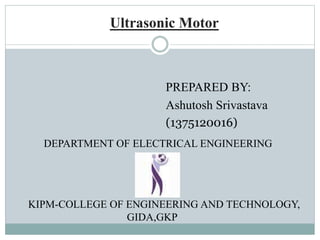Ultrasonic motor
- 1. Ultrasonic Motor PREPARED BY: Ashutosh Srivastava (1375120016) DEPARTMENT OF ELECTRICAL ENGINEERING KIPM-COLLEGE OF ENGINEERING AND TECHNOLOGY, GIDA,GKP
- 2. TABLE OF CONTENT ï INTRODUCTION. ï PIEZOELECTRIC EFFECT. ï STRUCTURE OF ULTRASONIC MOTOR. ï WORKING OF ULTRASONIC MOTOR. ï ADVANTAGES OF USM OVER EM MOTOR. ï DISADVANTAGES OF USM. ï MAJOR APPLICATIONS OF USM. ï CONCLUSION. ï REFERENCES. ï ADDITIONAL INFO.
- 3. INTRODUCTION âĒ It has been known for more than 30year. âĒ the first ultrasonic motor was introduced by V.V. Lavrinko in 1965. âĒ An ultrasonic motor is a type of electric motor formed from the ultrasonic vibration. âĒ Conversion of electrical energy into motion by inverse piezoelectric effect.
- 4. âĒ To obtain the levels of torque speed characteristics of USM using conventional motor we require to add a gear system to reduce the speed. âĒ these characteristics USM makes them attractive for robotics application where small motors are required. ContdâĶ
- 5. PIEZOELECTRICAL EFFECT Piezoelectric effect is conversion of mechanical pressure to electrical energy and conversion of electrical energy to mechanical pressure is known as inverse piezoelectric effect or Electrostriction. ï Piezoelectricity : generation of voltage in response of mechanical stress. ï This effect is also reversible. ï Piezoelectric materials are Quartz, Rochelle salt, Tourmaline, Lead Zirconium Titanate etc.
- 6. STRUCTURE OF ULTRASONIC MOTOR
- 7. ïStructure is divided into mainly four part: o The Stator part transmits vibration. o The Rotor which is a rotation part. o The Shaft which transmits rotation. o The Bearing. ï Furthermore, the structure of a stator part is the following: o The Piezoelectric Ceramics which generate vibration. o The Stator metal which makes vibration amplify. o The Friction material which contacts with a rotor.
- 8. Working of ultrasonic motor When electric voltage is applied on Piezoelectric Ceramics plate , due to piezoelectric effect it vibrate and as it is connect to stator , stator metal amplify the vibration. The Friction material which contacts with a rotor, is connect rotor and stator to vibrate at same frequency. Rotor start vibration and then at rotor metal surface a potential is induced due to Electrostriction(inverse piezoelectric effect) . When at rotor voltage is induced a travelling wave is generate which cause to create a torque which rotates the rotor.
- 9. Advantages of Ultrasonic Motor over Electromechanical Motor ïķ Electromechanical motors are famous for consuming high amount of power and creating high ambient motor temperatures respect to USMâs. ïķ the electromagnetic motors produce strong magnetic fields which cause interference. Ultrasonic motors use piezoelectric effect and hence no magnetic interference. ïķ Electromagnetic motor has high input to output energy loss ratios while USM has low power loss. ïķ USM high positional accuracy respect to electromagnetic motor.
- 10. ContdâĶ ïķ USM is characterized as low speed and high torque while EM motor is high speed and low toque. ïķ The efficiency of electromagnetic motors falls as their dimensions are reduced, but that of PUMs stay virtually constant. ïķ Linear electromagnetic motors are very difficult to design while PUMs are quite simple. ïķ USM has compact size and quite operation while EM motor has bulky and noisy operation.
- 11. ContdâĶ ïķ Different velocities without gear-mechanisms. ïķ USMâs are capable to work in extreme environment working condition.
- 12. Disadvantages of Ultrasonic Motors ï§ A high-frequency power supply is required.[in KHz range] ï§ As these motors operate on friction, durability is very less. ï§ Piezoelectric materials are expensive.
- 13. MAJOR APPLICATIONS ïą watch motors. ïą Used to inject oil into the burners. ïą Camera auto focus lenses. ïą Used to control the disk heads of computer like floppies, hard disk and CD drives. ïą In automobiles industry. ïą Aerospace. ïą Medicine(in magnetic resonance imaging scanning) ïą Robotics. ïą Power steering and car seat adjustment. ïą surveillance cameras.
- 14. Conclusion The above mentioned advantages and applications, concludes the scope of ultrasonic motors in day-to-day life. However the disadvantages brings up the need of further researches in the field of ultrasonic motors. Hence the ultrasonic motors, which is a new step in miniaturized electrical technology has got many applications in small appliances because of its high torque at low speed.
- 16. Additional Info ïž piezoelectric effect was discovered by Jacques curie and pierre curie[France-1880]. ïž first ultrasonic motor was developed by V. V. Lavrinko[Russia-1965].
- 17. THANK YOUâĶ..











![Disadvantages of Ultrasonic Motors
ï§ A high-frequency power supply is required.[in KHz
range]
ï§ As these motors operate on friction, durability is very
less.
ï§ Piezoelectric materials are expensive.](https://image.slidesharecdn.com/ultrasonicmotor-170413133304/85/Ultrasonic-motor-12-320.jpg)



![Additional Info
ïž piezoelectric effect was discovered by Jacques
curie and pierre curie[France-1880].
ïž first ultrasonic motor was developed by V. V.
Lavrinko[Russia-1965].](https://image.slidesharecdn.com/ultrasonicmotor-170413133304/85/Ultrasonic-motor-16-320.jpg)
